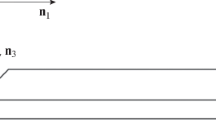Abstract
Experimental verification is used to show that reference specimens and structure unloading do not permit obtaining an adequate estimate of plastic strain by measuring the acoustic anisotropy. Analytic estimates of the speed of propagation of a plane acoustic wave of various polarizations in an elastoplastic material in the direction orthogonal to the action of preliminary uniaxial stress are obtained. An analysis of the obtained relations reveala an advantage of using absolute values of the velocity of longitudinal and transverse waves for the plastic strain identification. In contrast to acoustic anisotropy, the velocities vary monotonically in a wider range of plastic strains. At the same time, the elastic strain does not affect the longitude wave velocity, which allows one to use the measurement results to estimate the character of strains.
Similar content being viewed by others
References
D. S. Hughes and J. L. Kelly, “Second-Order Elastic Deformation of Solids,” Phys. Rev. 92 (5), 1145–1149 (1953).
M. Hirao and Y. H. Pao, “Dependence of Acoustoelastic Birefringence on Plastic Strains in a Beam,” J. Acoust. Soc. Am. 77 (5), 1659–1664 (1985).
Y. H. Pao, “Theory of Acoustoelasticity and Acoustoplasticity,” in Solid Mechanics Research for Quantitative Nondestructive Evaluation (Springer, Netherlands, 1986), pp. 257–273.
Y. H. Pao, T. T. Wu, and U. Gamer, “Acoustoelastic Birefringences in Plastically Deformed Solids. Part I: Theory,” J. Appl.Mech. 58 (1), 11–17 (1991).
M. Kobayashi, “Theoretical Study of Acoustoelastic Effects Caused by Plastic Anisotropy Growth,” Int. J. Plasticity 3 (1), 1–20 (1987).
M. Kobayashi, “Ultrasonic Nondestructive Evaluation of Microstructural Changes of Solid Materials under Plastic Deformation. Part I: Theory,” Int. J. Plasticity 14 (6), 511–522 (1998).
M. Kobayashi, “Ultrasonic Nondestructive Evaluation of Microstructural Changes of Solid Materials under Plastic Deformation. Part II: Experiment and Simulation,” Int. J. Plasticity 14 (6), 523–535 (1998).
N. Y. Nikitian, A. V. Kamyshev, and S. V. Kazachek, “The Application of the Acoustoelasticity Method for the Determination of Stresses in Anisotropic Pipe Steels,” Russ. J. Nondestruct. Testing 51 (3), 171–178 (2015).
J. Mandel and L. Brun, Mechanical Waves in Solids (Springer-Verlag, Wien, 1975).
A. S. Semenov, Computational Methods in Theory of Plasticity (Izdat. SPbGPU, St.Petersburg, 2008) [in Russian].
V. A. Babeshko, E. V. Glushkov, and N. V. Glushkova, “Methods of Constructing Green’s Matrix of a Stratified Elastic Half-Space,” Zh. Vychisl.Mat. Mat. Fiz. 27 (1), 93–101 (1987) [USSR Comput. Math. Math. Phys. (Engl. Transl.) 27 (1), 60–65 (1987)].
V. A. Babeshko, O. V. Evdokimova, and O. M. Babeshko, “The Integral Factorization Method in Mixed Problems for Anisotropic Media,” Dokl. Ross. Akad. Nauk 426 (4), 471–475 (2009) [Dokl. Phys. (Engl. Transl.) 54 (6), 285–289 (2009)].
L. B. Zuev, B. S. Semukhin, and K. I. Bushmeleva, “Variation of the Ultrasonic Velocity in Al under Plastic Deformation,” Zh. Tekhn. Fiz. 70 (1), 52–56 (2000) [Tech. Phys. (Engl. Transl.) 45 (1), 50–54 (2000)].
B. S. Semukhin, L. B. Zuev, and K. I. Bushmeleva, “The Velocity of Ultrasound in Low-Carbon Steel Deformed at the Low Yield Limit,” Zh. Prikl. Mekh. Tekhn. Fiz. 41 (3), 197–201 (2000) [J. Appl. Mech. Tech. Phys. (Engl. Transl.) 41 (3), 556–559 (2000)].
L. B. Zuev, B. S. Semukhov, and K. I. Bushmeleva, “Dependence of the Ultrasound Velocity on the Acting Stress during Plastic Flow of Polycrystals,” Zh. Tekhn. Fiz. 69 (12), 100–101 (1999) [Tech. Phys. (Engl. Transl.) 44 (12), 1489–1490 (1999)].
Author information
Authors and Affiliations
Corresponding author
Additional information
Original Russian Text © A.K. Belyaev, A.M. Lobachev, V.S. Modestov, A.V. Pivkov, V.A. Polyanskii, A.S. Semenov, D.A. Tret’yakov, L.V. Shtukin, 2016, published in Izvestiya Akademii Nauk, Mekhanika Tverdogo Tela, 2016, No. 5, pp. 124–131.
About this article
Cite this article
Belyaev, A.K., Lobachev, A.M., Modestov, V.S. et al. Estimating the plastic strain with the use of acoustic anisotropy. Mech. Solids 51, 606–611 (2016). https://doi.org/10.3103/S0025654416050149
Received:
Published:
Issue Date:
DOI: https://doi.org/10.3103/S0025654416050149



